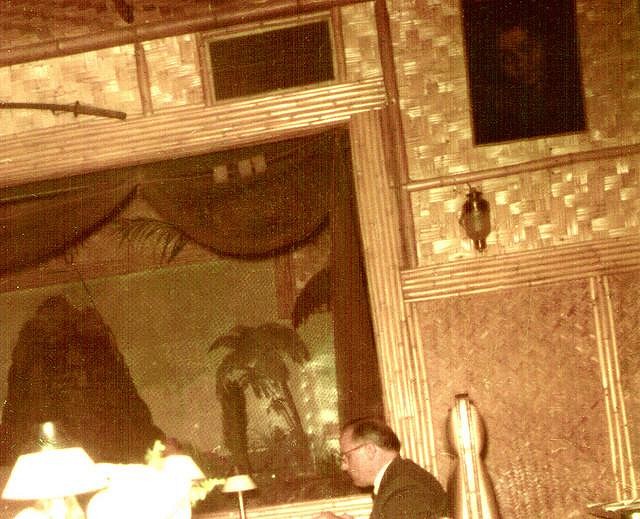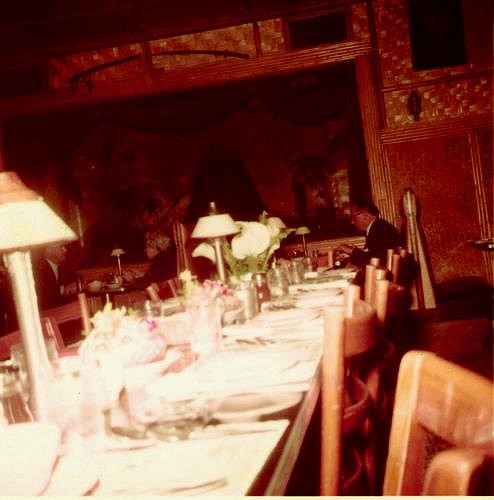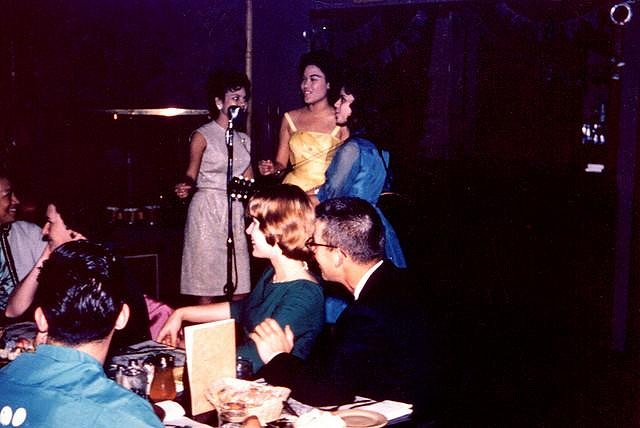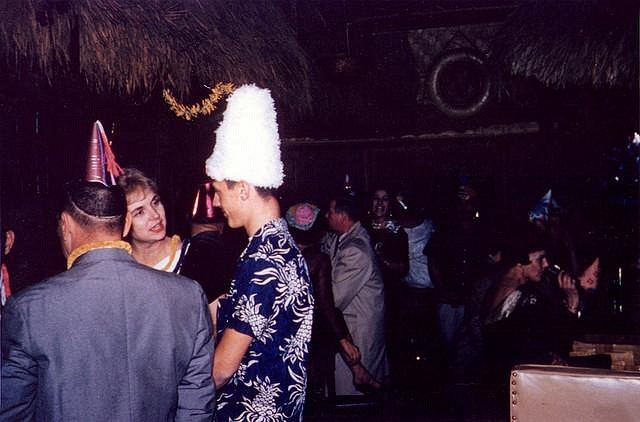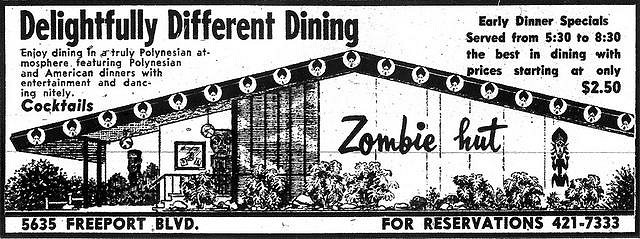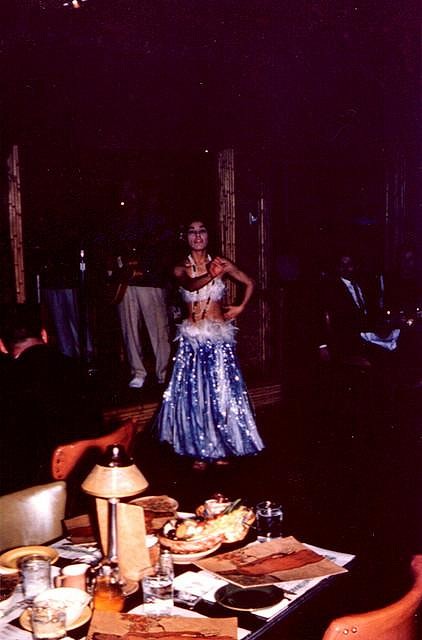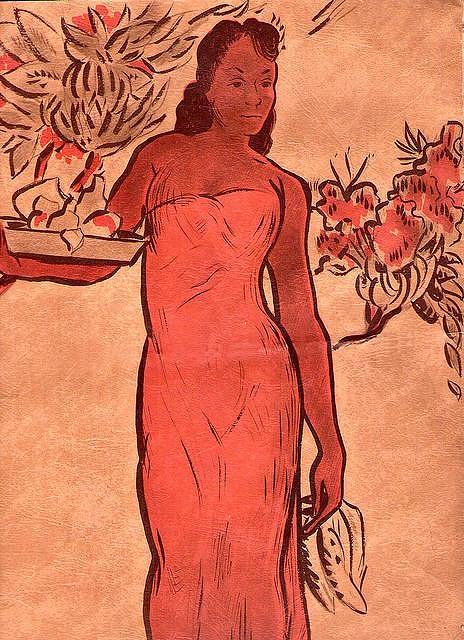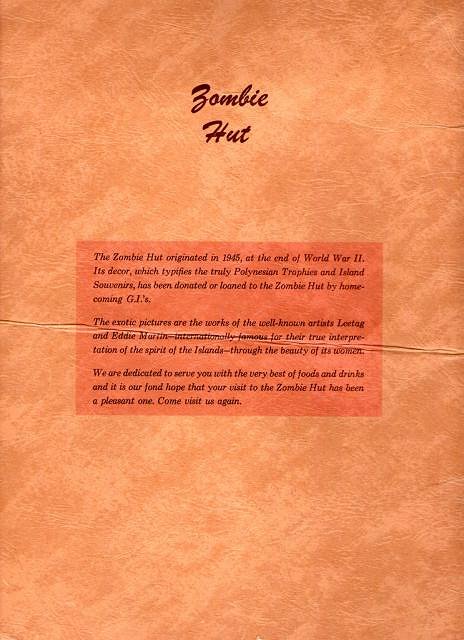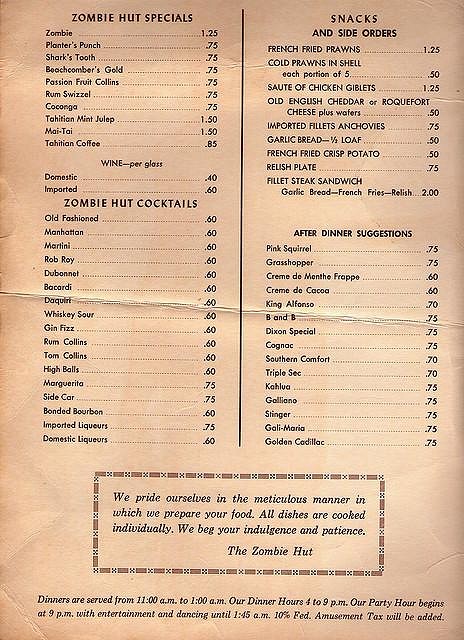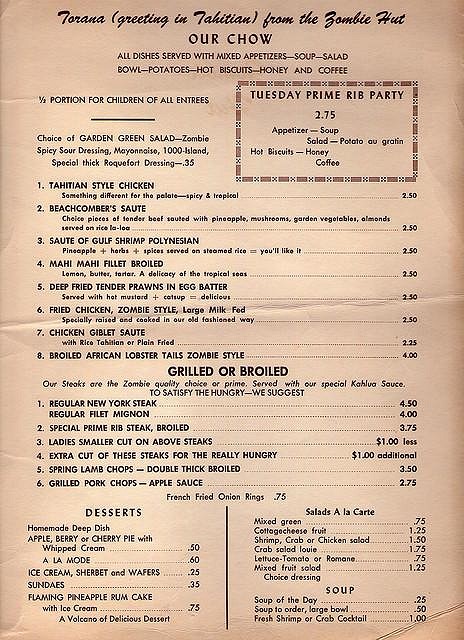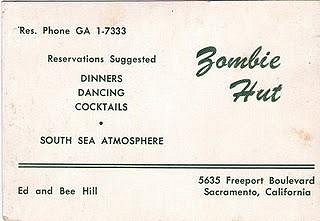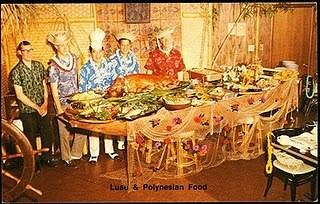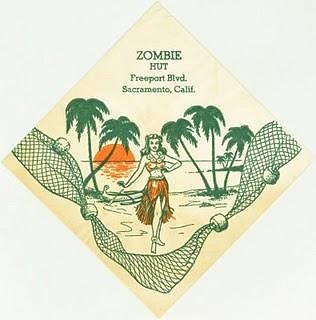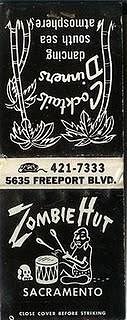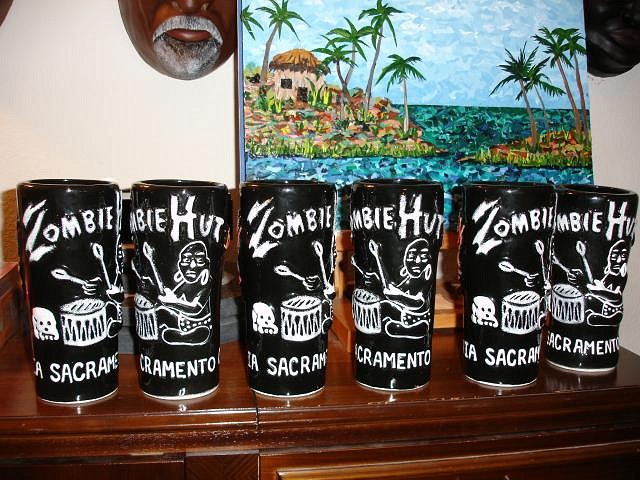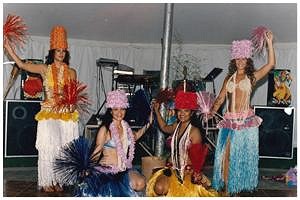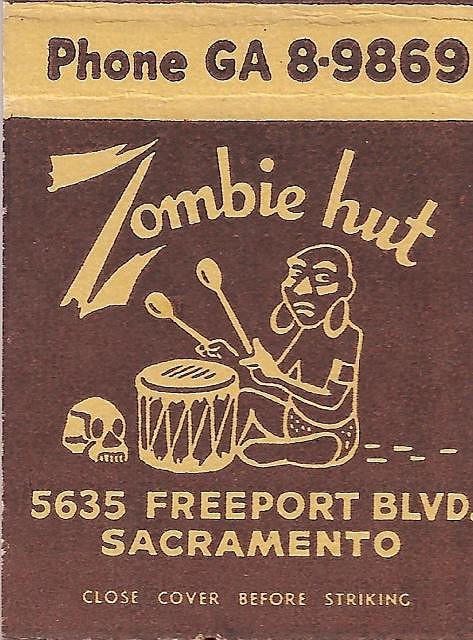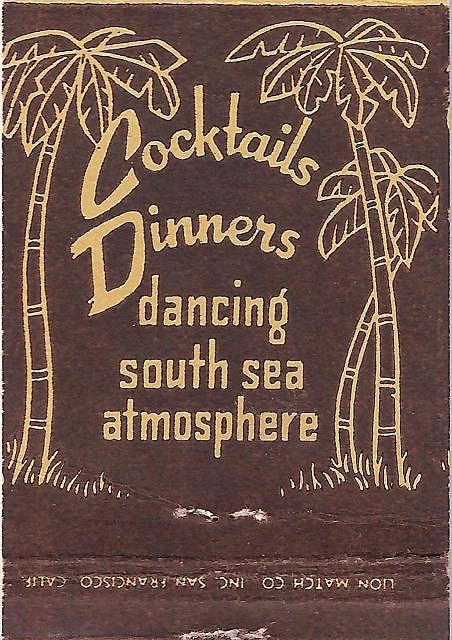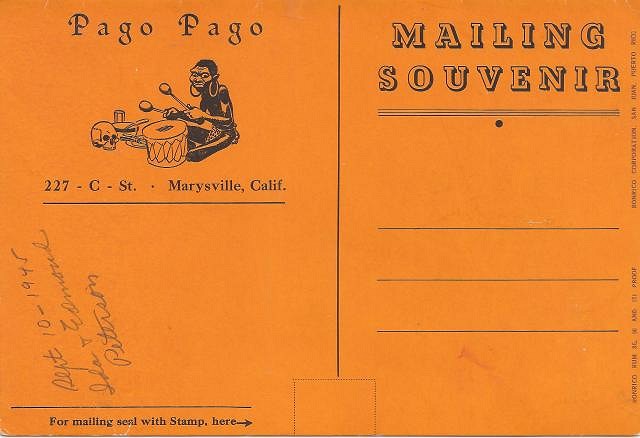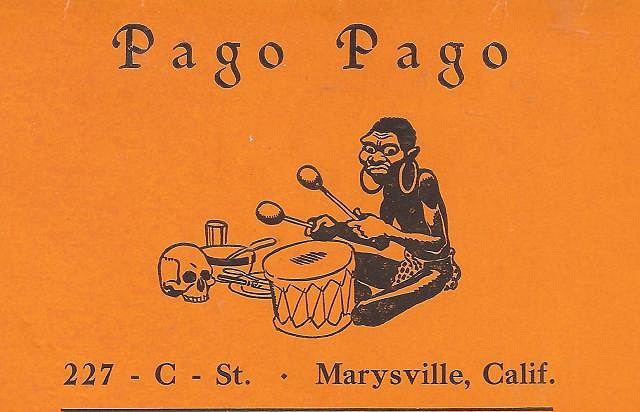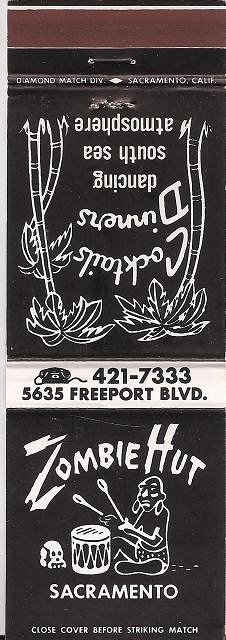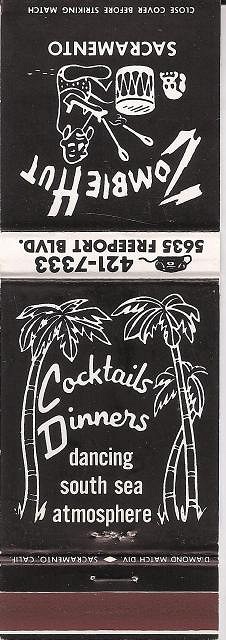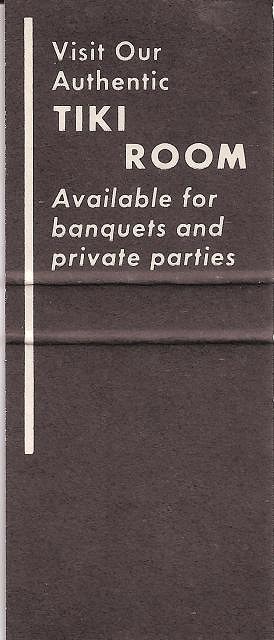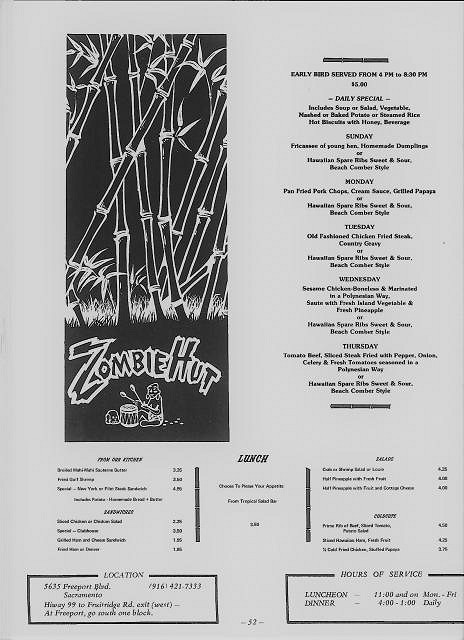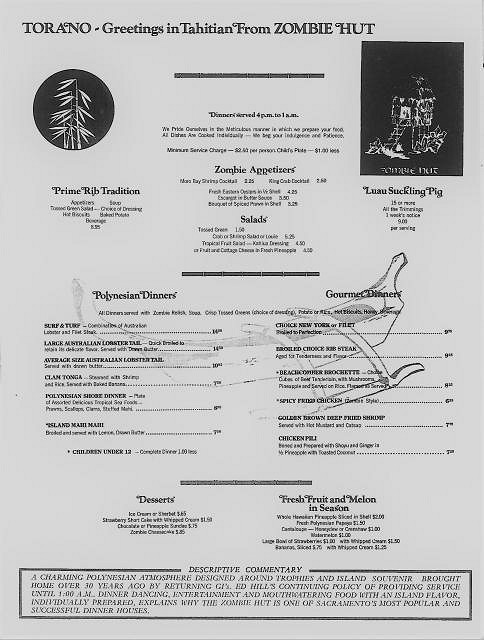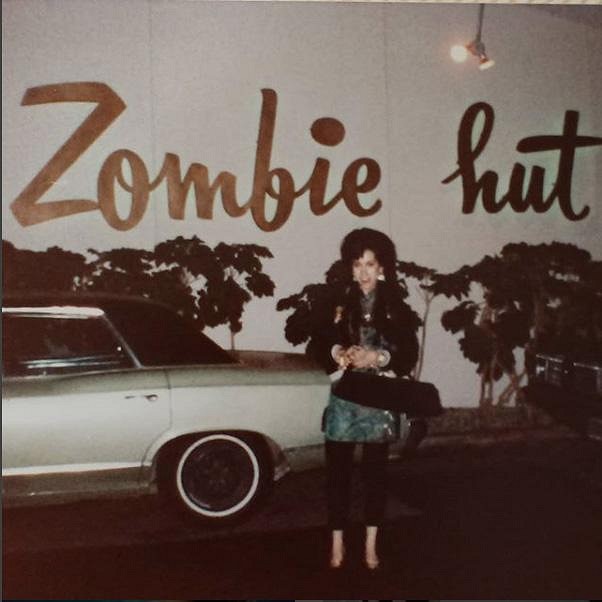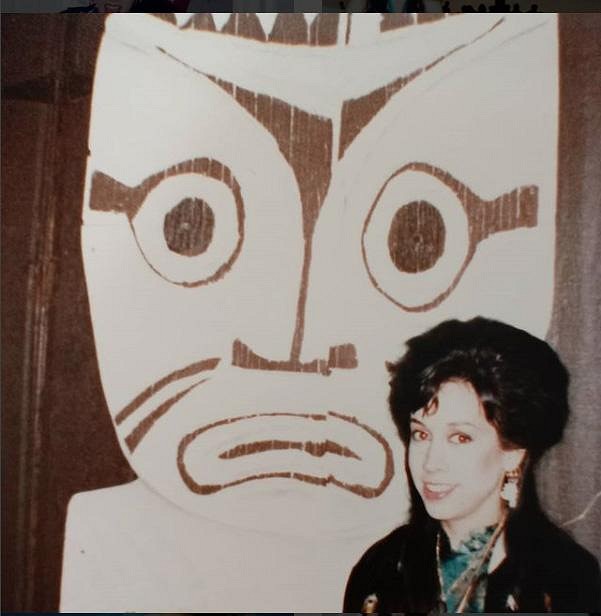Tiki Central / Locating Tiki
Zombie Hut, Sacramento, CA (restaurant)
Pages: 1 22 replies
|
PTD
Psycho Tiki D
Posted
posted
on
Thu, Sep 30, 2010 5:42 AM
Name:Zombie Hut Description: [ Edited by: Psycho Tiki D 2010-09-30 06:01 ] |
|
PTD
Psycho Tiki D
Posted
posted
on
Thu, Sep 30, 2010 5:55 AM
In light of our tribute mug for this year's crawl I wanted to add the Zombie Hut to Locating tiki. Here are a few images I "borrowed" from other sites...
Later, PTD [ Edited by: Psycho Tiki D 2010-09-30 06:23 ] |
|
D
Dustycajun
Posted
posted
on
Fri, Oct 1, 2010 7:01 AM
PTD, This thread is not complete without Wendy's amazing new mug for the upcoming Sacramento Tiki room tour.
DC |
|
B
bigbrotiki
Posted
posted
on
Fri, Oct 1, 2010 8:29 AM
Wow! Super cool! An instant classic. |
|
D
danlovestikis
Posted
posted
on
Mon, Oct 4, 2010 11:54 AM
Dustycajun thank you so much for posting a photo of my mugs so I could be part of this history. Ah thanks Sven, that means a lot. Thank you Duane for adding the mug to this thread and for thinking that we should make it. I just signed Gecko up for the last mug! Wendy [ Edited by: danlovestikis 2019-02-23 18:54 ] |
|
R
rugbymatt
Posted
posted
on
Tue, Oct 5, 2010 10:34 AM
The Zombie Hut, gone the way of the Kahiki. now a shite strip mall sits on the site. |
|
B
bigbrotiki
Posted
posted
on
Tue, Oct 5, 2010 12:31 PM
Yeah, I hate those white strip malls, too! Oh, wait... :D |
|
PTD
Psycho Tiki D
Posted
posted
on
Wed, Jun 29, 2011 6:14 AM
Found a little more information on the Zombie Hut and the cross-connection to The Hawaiian Hut in West Sacramento: Locals reminisce about south area’s famous Zombie Hut restaurant Sacramento has been home to a wide variety of restaurants throughout the years and among the most unique of these eateries was undoubtedly the Zombie Hut.
Despite the passing of two decades since its closure, the Polynesian-style business continues to be fondly remembered by its many guests and workers. Among the restaurant’s earliest customers were Pocket residents Norman and Dolores Greenslate. Dolores, the longtime historian and archivist of the Portuguese Historical and Cultural Society, said that the first owner of the business was a Portuguese man, named Johnny Quaresma. “(Quaresma) was a Portuguese fellow, who was known as Johnny Christmas,” Dolores said. “The story goes that somebody was saying ‘Quaresma’ and they were thinking that they were saying ‘Christmas,’ so he became known as Johnny Christmas. He owned the Zombie Hut originally and he may have had a (business) partner, I don’t know.” Quaresma sold the business in about 1952 and opened a similar restaurant, the Hawaiian Hut at 2400 West Capitol Ave. in West Sacramento. Dolores added that the restaurant’s Portuguese connection did not stop with Quaresma, noting that another Portuguese man, Eddie Cunha, who was recognized as one of the city’s best bartenders, worked at the Zombie Hut for at least 20 years. Another notable bartender at the restaurant in latter years included Eddie Cisneros. At the time of its opening, this dimly lit restaurant, which was known for its evening entertainment and its many tropical drinks with miniature umbrellas resting on their tops, was located within a relatively barren area, south of Sutterville Road. As opposed to today, this area near today’s Sacramento City College and William Land Park was much less built up and included few places during this era besides Capital Nursery, Raley’s grocery store, the Municipal Airport, Bob’s Bar-B-Q, The Stables tavern, a pair of liquor stores and the Ceccarelli residence. But the Zombie Hut, which included much Polynesian décor, was well situated for people in the Pocket area such as Dolores, who is a native of the area. “The Zombie Hut was the place to go out in that area,” Dolores said. “We used to go there after Norman came back (from World War II). I also used to go there for fashion shows later on when (another owner) Ed Hill had the place. The women used to go over there for the (fashion) shows, but then the men did, too, because there was lingerie.” Place for Polynesian music The Zombie Hut’s most renowned entertainment and a staple of the venue was its Polynesian music and dancing acts.
“While I was attending (Sacramento) City College and living (at 2415 33rd Ave.), Alvin Inaba, whose parents owned the whole block where the Zombie Hut was located, used to take me to the Zombie Hut,” Snyder said. “I would see the entertainment there and it was the first place I ever had a prime rib dinner. We would go to the Zombie Hut and then to the Music Circus, because his sister was in the Music Circus. I remember seeing the dancers (at the Zombie Hut) and some kind of act with fire. For Sacramento, this was quite the thing. Back then you only had the Sacramento Inn, the Hotel Senator and the Zombie Hut was right up there, because of the entertainment.” Albert Sakalata, a Tongan-born musician who began entertaining at the venue in 1963, recalled his first memories of the Zombie Hut. “I was asking people where I could find a Hawaiian restaurant and they told me to go to the Zombie Hut,” Sakalata said. “When I first went there (to the Zombie Hut), I was really shocked to see there were torches lined up with fire outside the restaurant and the place was like the (Polynesian-themed) Trader Vic’s restaurants down south in L.A. I was with two Tongan boys (Fono Manu and another with the last name of Tofanaha) and we all decided that we were going to work at this place. They approached us and asked us that night to perform a couple songs on stage (with the Lee sisters from Hawaii and their brother, Fred Lee, the drummer) and we were hired on the spot.” Sakalata, who first came to the United States in 1959 when he studied accounting at the Church College of Hawaii – today’s Brigham Young University-Hawaii – and helped build and open the world-famous Polynesian Cultural Center in Laie, Hawaii, said that he worked at the Zombie Hut for two years before going back to Tonga. Returning to the United States in 1974, Sakalata, 70, began playing music with his brothers on a touring cycle, which included stops in Albuquerque, Tucson, Lake Tahoe, Stockton and Fresno. A changing time As Polynesian-themed restaurants were losing much of their nostalgic popularity in the 1970s and the Zombie Hut was in need of various improvements, Hill contacted Sakalata to provide entertainment and become the restaurant’s manager. Sakalata, who also took the stage with a Samoan musician, named Tasili Ngaleai, entertained at the Zombie Hut on Tuesdays through Sundays, from 8 p.m. to 2 a.m. Accompanying Sakalata’s group, the Royal Polynesians, at various times were several dancers, including Trudy Lawrence, who was also a singer, Ngaleai’s sister, Losa, Turia (Giles) Davis, Katherine (Giles) Marchand, Evelyn Meredith, Debbie Kassis and Cheryl Cook. Davis, who was born on the island of Bora Bora in the South Pacific and was a part of the Zombie Hut dance troupe from 1963 to 1969 and from 1985 to 1987, said that her professional dancing career continued until about 2007. Commenting about one of her favorite dancing memories, Davis said, “My mom and dad (Fred and Tetua Giles) were at the Zombie Hut for years. I loved that and of course my mother was Polynesian (from Tahiti) and my dad always supported our Polynesian heritage. They were always big on supporting any of the Polynesian programs and events. I really enjoyed having them there. But it was not just them (who were regulars). There were a number of people who came there almost every weekend and just became part of the scenery more or less.” Cook, who began dancing at the Zombie Hut when she was 15 years old, said that many former Zombie Hut musicians and dancers continue to perform together at various events. “The Zombie Hut’s Hawaiian floor show still lives on,” Cook said. “Albert and his Hula Lovelies, as he called us, still entertain at backyard parties, corporate events and country clubs with the group, Aloha Polynesia.” Although the Zombie Hut was definitely not Sacramento’s first or last Polynesian-themed eatery and nightclub, it was widely considered the most popular of these places. Predating the Zombie Hut was the Tropics nightclub, which opened at 1019 ½ J St. in 1943. This business, which advertised itself as the “Pacific Coast’s most beautiful nightclub” with “dancing, entertainment and tropical drinks,” appears to be where Quaresma may have obtained his idea to establish the Zombie Hut. The Tropics owners were Yubi Separovich, who lived at 2712 13th St., where Quaresma eventually lived, and Frank Radich, who resided at 2716 13th St. Another similar business in latter years was Albert’s Tiki Village at 3514 Marconi Ave. at Watt Avenue. Owned by Albert Mar, the restaurant boasted its “superb Polynesian cuisine.” Quality cuisine The Zombie Hut also had its fair share of quality cuisine, as it served such offerings as steak, prime rib, scampi, lobster, scallops, mahi mahi, salads and roast pig on the weekends for luas and banquets. And people came from many directions outside of Sacramento to enjoy the food, drinks and entertainment. Among the Zombie Hut’s most famous guests were John Wayne, Eddie Fisher, Joey Bishop, Joan Crawford, George Montgomery, Cliff Robertson and Eddie Murphy. A lot of the draw of the Zombie Hut was its unique interior, which included a bamboo décor with many round tables that were individually illuminated by hanging blowfish lights, artificial coconut trees, a 15-foot-wide tropical storm, waterfall area, blacklights, recorded bird sounds, island-themed artwork, a thatched roof stage near the center of the restaurant, four canoes hanging from the ceiling, masks, spears, tiki idols and a large taxidermy collection that included the heads of moose, elk, goats and other animals brought back from Quaresma and Hill’s hunting trips. Remembering the inside of the Zombie Hut, Sakalata said, “It was like walking into a jungle.” Complimenting the Zombie Hut for a very brief time was Lucille Andrews, Olive Christian and Dixie Lockett’s Hawaiian Imports gift store, which opened at 5677 Freeport Blvd. in about 1959. Although Sakalata brought a much needed boost to the restaurant, by the late 1980s, the restaurant changed drastically under its last owner, Bruce Brooks. During this time, the venue featured Love Boat theme and disco music shows and eventually discontinued its entertainment offerings. Additionally, the restaurant replaced its former menu with a fast food-style menu and was only open on the weekends during the evenings. Sakalata left his position as the Zombie Hut’s manager in 1989 to begin his own Polynesian-style restaurant, called the Island Marina, in the Sacramento Delta and by the following year the Zombie Hut closed its doors to the public for the final time. The building was demolished many years ago and the strip mall that now stands in its place includes a self-serve dog wash and bakery at the Zombie Hut’s old address. Gone but not forgotten While Sacramento has been without its once beloved Zombie Hut for the past 20 years, a tribute to the Zombie Hut appeared in 2002, when former Zombie Hut busboy Tod Bullen opened a similar restaurant by the same name in Brooklyn, N.Y. Sakalata, however, feels that the timing is right to reintroduce a Zombie Hut-like eatery and entertainment venue to the Sacramento restaurant scene. “Right now, I think that there really should be a place like the old Zombie Hut (in Sacramento),” Sakalata said. “People of this generation are going to the Pacific Islands for vacations, like (to) Fiji, Tonga and Samoa and New Zealand, Australia and Hawaii. They are coming back with the nostalgia of the islands. If somebody could come up with a place like the Zombie Hut, I honestly think that it would be very successful.” But in the meantime, the old Zombie Hut has left plenty of memories behind. Good read! PTD [ Edited by: Psycho Tiki D 2011-06-29 06:23 ] |
|
D
Dustycajun
Posted
posted
on
Wed, Jun 29, 2011 8:18 PM
PTD, Nice to find out about the Zombie Hut - Hawaiian Hut connection. Here is the brown version of the matchbook I got in a trade with PTD of course.
DC |
|
B
bigbrotiki
Posted
posted
on
Thu, Jun 30, 2011 3:25 PM
PTD, amazing article. It sez it all: The evolution and devolution of Polynesia Americana all in one local place, what a great story! |
|
PTD
Psycho Tiki D
Posted
posted
on
Fri, Jul 1, 2011 6:08 PM
Ironically, I came across this obituary this afternoon. My previous posting mentioned the final Zombie Hut owner as Bruce Brooks; this is for his wife Betty. There is a small blurb about her enjoying singing at their restaurant The Zombie Hut: http://www.legacy.com/sacbee/DeathNotices.asp?Page=LifeStory&PersonId=152291051 Later, PTD |
|
D
danlovestikis
Posted
posted
on
Fri, Jul 1, 2011 8:07 PM
Thank you for this information Duane. Since Dan and I dated there before and after we married your information brought back a lot of great memories. Wendy |
|
A
abstractiki
Posted
posted
on
Fri, Jul 1, 2011 9:20 PM
That's a lot of great info PTD, nice work. |
|
D
Dustycajun
Posted
posted
on
Mon, Dec 3, 2012 9:29 PM
I have this souvenir mailer from the Pago Pago in Marysville circa 1945 that features a very similar image to the Zombie Hut drummer...
They decided to take away the plates and utensils from the image at the Zombie Hut for less of a "cannibal" concept!
Tiki Transmission Tradition! DC |
|
B
bigbrotiki
Posted
posted
on
Tue, Dec 4, 2012 10:06 PM
Hmmm...that looks more like the ORIGINAL that the Zombie Hut matchbook image was taken from? Does anybody have any info about that Marysville Pago Pago? |
|
D
Dustycajun
Posted
posted
on
Tue, Dec 4, 2012 10:44 PM
Bigbro, You must have misinterpreted my post. Clearly the 1945 Pago Pago menu was the inspiration for the Zombie Hut logo almost two decades later. I thought it was funny that the Zombie Hut version nixed the plate, bowl and utensils from the Pago Pago version that had to connote some cannibal overtones! As for the Marysville location, I had posted some info on that in your Pago Pago thread. DC |
|
B
bigbrotiki
Posted
posted
on
Wed, Dec 5, 2012 12:33 AM
Sorry, missed that little "plate & fork" comment, very observant! Just went by the date, being that the Zombie Hut started in '45 too. THAT Pago Pago, with that great exterior mural! Man there is just too much to remember! |
|
D
Dustycajun
Posted
posted
on
Tue, May 21, 2013 7:33 PM
Picked up one of the black Zombie Hut matchcovers.
What's cool about his is they advertised a Tiki Room on the back of the cover.
DC |
|
S
SandraDee
Posted
posted
on
Tue, May 21, 2013 8:07 PM
DC love when you hit that paper show my friend! |
|
D
Dustycajun
Posted
posted
on
Tue, May 21, 2013 8:30 PM
How did you know?? Grog tell you? DC |
|
PTD
Psycho Tiki D
Posted
posted
on
Sat, Mar 10, 2018 9:39 AM
Found a menu in a magazine called "Dining Out" guide from the late 1970's-I have yet to actually see an actual Zombie Hut menu, but this will suffice for now.
Psycho Tiki D |
|
O
Otto
Posted
posted
on
Fri, Dec 14, 2018 10:22 AM
Found these two pics on Pearl Harbour's instagram page https://www.instagram.com/pearlharbourmusic/
[ Edited by: Otto 2018-12-14 10:24 ] |
|
O
Otto
Posted
posted
on
Sat, Dec 22, 2018 8:40 PM
Looking at this I was wondering why Pago Pago, the capital of American Samoa, would be associated with cannibalism. So I looked it up on Wikipedia and got: It's interesting how the Tiki bar Zombie phenomenon would then incorporate the Tiki bar cannibalism curiosity which has a deep tradition in Tiki bars as the cannibal carving trio Pretty amazing how the original drawing is so direct in its cannibalism. A native drummer also cooking humans (human skull) and that is the iconography for a restaurant. Like the icon for a Rib Joint being a happy Pig with a BBQ grill.
|
Pages: 1 22 replies

